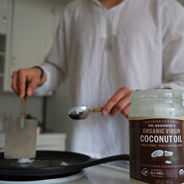How to Eat Healthy on a Budget (7 Tips)
- Christian Van Camp

- Apr 30, 2020
- 8 min read
Updated: May 1, 2020
Let's crumble-up the myth that you can't sustain a nutritious diet on a restrictive budget...

Sure, some above-and-beyond healthful foods and supplements can be expensive, difficult to access, or not as appetizing (i.e. blue-green algae). It can be a real challenge eating healthy when on a tight budget, in a rush, or don't have the proper resources nearby. Despite these common restraints, it is very much possible to whip-up colorful salads and smoothies.
Personally, I don’t pay for the quality fruits, veggies, and grass-fed meats because it's my choice. I pay for those things because it's my body’s choice.
What does better health mean to you?
For me, it's holding steady brain power from dusk to dawn. It’s communicating my exact intentions. It's being able to extrapolate healthy memories from my inner workings. It's retaining a smile day in and day out. It’s being able to move fluently and functionally without stiff joints and achy muscles. It’s that glowing complexion free from acne and inflammation. It's waking up with the sun amped-up and ready to get shit done. It’s craving vibrant, colorful whole foods without the lingering temptation to pick up that salty chip or sweet sugar cookie.
In order to become superhuman and achieve your dream career, relationships, and livelihood, your health has to come first. After you make the choice to put your mental, physical and spiritual health as numero uno—happiness follows.
You can manage to get those dark leafy greens in your fridge no matter how much green you have stacked-up in your bank.
With that in mind, here are the top tips to maintain a sizable wallet while still being able to eat wholesome, delicious, and mood-boosting foods:
1. Organic?
Organic is the healthiest option, right? Not too fast, there’s actually a great deal of foods you don’t necessarily need the bold “USDA Certified Organic” slapped on the front.
Some non-organic fruits and veggies are heavily sprayed in chemicals like glyphosate, but others require very little use of these pesticides because of their innately resistant growing process. These non-organic plant medicines are known as the Clean 15. The Environmental Working Group (EWG) creates a research-backed list every year based upon societal demand and the ever-changing agricultural systems of common fruits and vegetables.
If you’re tight on a budget I recommend you aim for these non-organic guys because they contain the lowest amount of pesticide residue:
Avocados
Sweet corn
Pineapple
Onions
Papaya
Sweet peas (frozen)
Eggplants
Asparagus
Cauliflower
Cantaloupes
Broccoli
Mushrooms
Cabbage
Honeydew melon
Kiwi
On the contrary, buy organic for the Dirty Dozen whenever possible. Although slightly more expensive for your bank statement, they are quite an affordable purchase for your health. This Dirty Dozen list is saturated in a plethora of harmful toxins. When consumed day after day, a variety of health issues may come to light, from massacring your microbiome to booming nasty brain fog:
Strawberries
Spinach
Kale
Nectarines
Apples
Grapes
Peaches
Cherries
Pears
Tomatoes
Celery
Potatoes
2. Frozen, Canned & Bulk
If you check out the frozen aisle at any grocery store and compare the cost per ounce to it’s fresh counterpart, nine times out of ten, frozen meditates as the cheaper guru.
My go-to frozen staples are organic kale, broccoli and turnip greens, along with my top-tier smoothie enhancer— the antioxidant-rich, brain-boosting and mouth-watering wild blueberries.
But berries aren’t the only smoothie enhancer. Mixed greens and cruciferous vegetables are viable options to toss into the blender. Plus you can easily kick-up the nutrient density without jeopardizing the flavor. Trust me, you won’t taste a cup of spinach and carrots blended with a scoop of flavorful protein such as Ancient Nutrition Chocolate Bone Broth stacked with low-glycemic berries, cacao nibs, nut butter, monk fruit extract, hemp seeds and other tasty, nutrient-rich foods. Salads aren’t the only way to get your daily dose of green…
Everyday around 1pm I break my daily 14-16 hour intermittent fast with a smoothie; loaded with frozen broccoli, cauliflower, mixed greens, berries, and maybe if I am feeling frisky, I will throw in frozen mango or pineapple for a tropical vibe.
Purchasing grocery items in canned and bulk is another must for your bank statement. Canned or bulk dried beans, lentils, rice and ancient grains not only last for an eternity in the pantry but they also run much lower on the pricetag scale.
Costco and Sam’s Club are fantastic locations that offer a wide variety of canned items from sardines to mushrooms to chicken breast. They also have a great deal of bulk beans and grains which can easily fit anyone’s budget.
Just make sure you properly prepare these guys to avoid any digestive discomforts like bloating, indigestion and gas. In order to break down the antinutrients like lectins and phytates, you must soak, sprout, ferment or cook thoroughly with a pressure cooker. This will lead to better nutrient-absorption and less atomic bombs on the toilet.
Don’t have access to Costco or Sam’s? That’s fine and dandy! Simply stroll through an Aldi, Trader Joe’s, a local co-op or any other cost-effective grocery store nearby. Practically every market carries dried, canned and frozen options.
3. Generic vs Name Brand
As fancy as you want to be, it may be best to pick up that cheesier designed package instead of name brand. No, not cheese, but the funkier, less illustrious logo.
Generic brands aren’t necessarily always going to be cheaper so use your best discretion when comparing prices. If you utilize coupons, price match options or shop for sales you can indeed find name brand products for that low-low. The Wall Street Journal pointed out that generic prices are around 29% cheaper than name-brand.
I almost always opt for the generic brand, even if it’s just a meager 5 cents cheaper. Otherwise, base your decision on your best interest when in the aisles. Don't just grab the generic brand and assume it's cheaper. Compare the price per ounce tags, and don’t be fooled by the discounted “ON SALE!” store tactic. Sometimes a name brand is cheaper on sale, but it's not always the case... go with your gut!
4. Grocery Growls
Shopping hungry will cause unwanted impulse buys and cravings for food you truly wouldn’t want otherwise. I have gone home with a receipt 3x longer than what my grocery list actually entailed because I didn't shop on a full stomach. Not the move for a healthy budget.
So, if you plan on going grocery shopping, fill up the tank prior with low glycemic foods packed in protein and healthy fat. This will limit insulin spikes (aka cravings) from taking control of the wheel. Surging insulin through sugary, processed foods triggers cravings for the crap— therefore cashing-out your precious coins. You’ll end up like high school me wandering the aisles seeking out more chips, cookies and other addictive/expensive foods (expensive not only for your wallet, but expensive for your health).
5. Cyberspace Markets
One of my favorite online resources for food is Thrive Market. This place is chock-full of supplements, meat and seafood, pet and cleaning supplies, cooking and baking staples and healthy grocery items for you and your family (or friends). You just have to pay a membership fee of $10 a month or $60 a year. Totally worth it.
I consider Thrive Market the cheaper and healthier Amazon of the food industry. But this isn’t the only URL out there. You can also find hundreds of other online markets that offer healthy eating for anyone on a budget. And the best part is, you don’t have to leave your house to get the goods!
6. Home Cookin'
Now that it's 2020 it couldn’t be easier to pick up an oily Big Mac or swing through the Sonic drive thru for a sweet treat. It’s hard to beat the convenience of eating out.
In the short-run it may seem better on the budget, but in all honesty, eating out exponentially depletes your bank account. Eating out is estimated to be 5x more expensive than cooking at home. That’s why I decided to opt out of the fast-food game. Not only because it wrecks my mood, skin, digestion and drive but because whipping-up a delicious and nutritious meal at home is fun and empowering.
According to a Johns Hopkins study, those who frequently cook at home are much more likely to consume less calories and eat more wholesome food—aka live longer and happier. 57% of fast food restaurants have menu items that exceed the American Heart Association’s recommendation of 1,500mg sodium (20% of the “foods” exceed 2,300mg).
That’s considered an entire day's worth of sodium in one messy meal. It all starts with puffy eyes and high blood pressure, and eventually after eating these foods months on end, the ‘minor‘ symptoms evolve into heart disease (the number 1 killer in the US).
Also, put this in your back pocket: around 40% of the food in fast food restaurants contain high amounts of antibiotics. But, luckily, Chipotle and Panera Bread stand out of this infected crowd. They are some of the few restaurants out there without this antibiotic issue in their foods. Props to them.
Sure, eating out eliminates the hassle of grocery shopping, cooking, and cleaning up, but it also eliminates a true connection to the food and people around you. I’m not saying completely ditch the professionally-prepared red curry and sticky rice, but limit how often you go out if you're concerned with a financially stable budget. Yeah yeah yeah, I know there’s only 10% of you guys reading this that truly enjoy cooking regularly at home, yet now that COVID-19 is here, we have no other choice but to tie on our aprons and prop up our chef’s hats.
7. Grow It!
Last but not least, it's time to revert back to our roots. How did humans even make it to the 21st century? Yes, you guessed it— a lot of bangin’.
Okay, not for real. But you can’t argue that that there has been a tremendous amount of sexual reproduction as a collective species... that’s only one factor to human evolution. I actually want to dive into our agricultural and livestock revolution.
We take grocery trips for granted in this day and age. Just think about it: most of us can drive less than 10 minutes to any supermarket for plant medicines and animal products we can easily cultivate ourselves for half the cost. Humans have been surviving off of mother nature’s nutrient-dense vegetables, fruits, grains, goats, cows, pigs, chicken, et cetera, so why have we just now decided to take the lazier route?
We not only survived off our own food production for millenia... we thrived. Humans used to work for our health and livelihood. To be honest, that is way more financially fulfilling than driving to the market and plopping the food into a grocery cart. It's time to rekindle our true connection to nature with home gardening.
Gardens are a delightful brisk walk from your back door and they can easily be organic and free from harmful chemicals. AKA these whole foods will be much better for the planet and your health.
Looking beyond financial freedom and physical health, growing it is mentally uplifting. Harvesting your own baby plants and animals (i.e. eggs) alleviates stress and ignites ancestral fire. Soak up some warm sunshine, cool breeze, higher income stacks and grow it all!
BONUS
If you made it this far, you're in for a treat. Here's my go-to list of items that I purchase every week during my ventures to the grocery shop. It keeps me AND my credit card happy...
- Eggs
- Sardines, tuna, and other canned fatty fish
- Frozen salmon fillets (wild caught option at Aldi for $1 per 4 oz fillet)
- Whole chicken (preferably pasture-raised organic)
- Organ meats like liver and heart (significantly cheaper per pound than less nutritious muscle meats)
- Dried beans, ancient grains (typically quinoa) and lentils
- Steel cut oats
- Frozen veggies (broccoli is one of my favorites)
- Sweet potatoes
- Hummus
- Veggie-based pasta
Bouncing off of this extravagent info, the EWG took it a step further through a detailed food ranking system that "balances nutrition, cost and environmental health concerns."
EWG researchers analyzed over 1,200 different foods and compared average food prices. They also identified the most nutritious foods that are easy on your bank account and the planet.
- Raw cabbage is a top-ranked vegetable based on nutrition and price. At less than a dime a serving, it's cheaper than potatoes and can be served as a salad, stuffed, or used in sandwiches, stir-fries, stews and soups.
- Carrots, bananas, frozen broccoli, pears and watermelon receive high marks for nutrition and ring up at less than 30 cents a serving.
- Pears have even more fiber, potassium and folate – and fewer pesticide residues – than apples.
- Parsley packs a nutritional punch as potent as kale for a quarter of the cost.
- Roasted turkey topped the list of animal sources of protein. Hot dogs ranked dead last.

































Comments